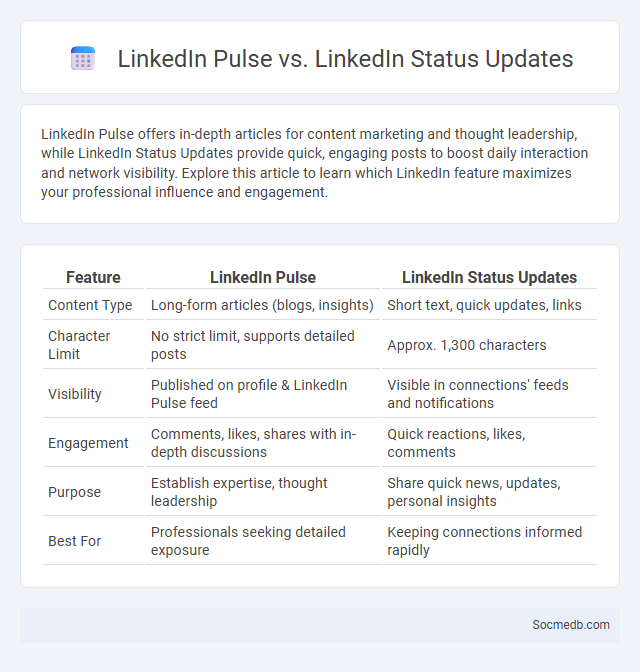
Photo illustration: LinkedIn Pulse vs LinkedIn Status Updates
LinkedIn Pulse offers in-depth articles for content marketing and thought leadership, while LinkedIn Status Updates provide quick, engaging posts to boost daily interaction and network visibility. Explore this article to learn which LinkedIn feature maximizes your professional influence and engagement.
Table of Comparison
| Feature | LinkedIn Pulse | LinkedIn Status Updates |
|---|---|---|
| Content Type | Long-form articles (blogs, insights) | Short text, quick updates, links |
| Character Limit | No strict limit, supports detailed posts | Approx. 1,300 characters |
| Visibility | Published on profile & LinkedIn Pulse feed | Visible in connections' feeds and notifications |
| Engagement | Comments, likes, shares with in-depth discussions | Quick reactions, likes, comments |
| Purpose | Establish expertise, thought leadership | Share quick news, updates, personal insights |
| Best For | Professionals seeking detailed exposure | Keeping connections informed rapidly |
Introduction to LinkedIn Content Options
LinkedIn offers a variety of content options designed to help professionals engage with their network and showcase expertise. You can share articles, posts, videos, and documents to provide valuable insights and facilitate meaningful conversations. Leveraging these content formats effectively enhances your personal brand and expands your professional reach.
What Is LinkedIn Pulse?
LinkedIn Pulse is a content publishing platform integrated within LinkedIn that enables professionals to share original articles, insights, and industry news with their network and beyond. It leverages LinkedIn's extensive user base to amplify content visibility, helping users establish thought leadership and engage with target audiences effectively. This platform supports business networking, personal branding, and content marketing by providing analytics and distribution tools tailored to professional communities.
Understanding LinkedIn Status Updates
LinkedIn status updates play a critical role in professional branding by enabling users to share industry insights, career milestones, and thought leadership content with their network. Optimizing these posts with relevant keywords, hashtags, and engaging multimedia increases visibility and fosters meaningful connections within targeted professional communities. Regular, authentic updates enhance profile activity, improve algorithmic reach, and position users as influential voices in their sectors.
Key Differences: Pulse vs. Status Updates
Pulse provides real-time, dynamic insights into your social media activity by aggregating data from multiple channels, whereas Status Updates focus on concise, immediate posts shared directly with your followers. Your Pulse acts as an analytical hub highlighting trends, engagement metrics, and content impact over time, while Status Updates serve to communicate specific thoughts, announcements, or promotions instantly. Understanding these key differences helps you leverage each tool effectively for enhanced audience connection and strategic content management.
Advantages of Using LinkedIn Pulse
LinkedIn Pulse offers a powerful platform to amplify your professional voice and showcase your expertise to a global audience. Leveraging LinkedIn Pulse enhances your personal brand, fosters valuable industry connections, and drives targeted traffic to your profile or business page. Investing time in creating quality content on LinkedIn Pulse can significantly boost your network growth and career opportunities.
Benefits of LinkedIn Status Updates
LinkedIn status updates enhance professional visibility by allowing users to share industry insights and career achievements, fostering stronger networking opportunities. These updates enable real-time engagement with connections, increasing content reach and encouraging meaningful conversations. Consistently posting status updates also positions individuals as thought leaders, boosting personal brand credibility within targeted professional communities.
Audience Reach and Engagement Comparison
Social media platforms differ significantly in audience reach and engagement rates, with Facebook boasting over 2.9 billion monthly active users, making it ideal for broad visibility. Instagram and TikTok excel in higher engagement through visual and short-form content, appealing to younger demographics with average engagement rates of 1.22% and 5.96%, respectively. You can optimize your marketing strategy by selecting platforms that align with your target audience's preferences and interaction patterns.
SEO Impact: Pulse vs. Status Updates
Pulse articles generate higher engagement and improved search engine rankings due to their in-depth content and optimized keywords, making them more effective for SEO compared to short status updates. Status updates, while frequent and timely, often lack keyword density and comprehensive information, resulting in limited SEO impact. Consistent publishing of detailed Pulse posts drives organic traffic and enhances brand authority in search results.
When to Use Pulse vs. Status Updates
Pulse updates are ideal for sharing in-depth insights, detailed project progress, or substantive company news that requires thoughtful engagement. Status updates work best for quick, real-time information such as brief announcements, immediate feedback, or micro-milestones. Choosing the right format ensures Your message captures attention effectively and maximizes audience interaction.
Conclusion: Choosing the Best LinkedIn Content Format
Selecting the optimal LinkedIn content format depends on your audience's preferences and engagement patterns, ensuring maximum reach and interaction. Visual formats like videos and infographics tend to generate higher engagement rates, while well-crafted articles establish thought leadership and trust. Align your content strategy with these insights to effectively boost Your LinkedIn presence and achieve professional goals.
 socmedb.com
socmedb.com